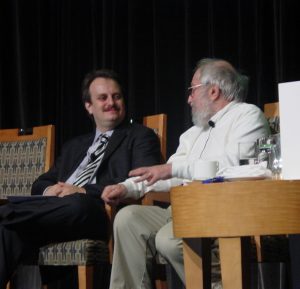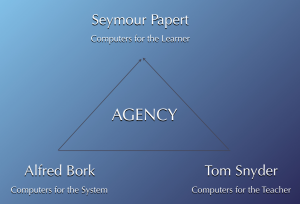Back in the late Eighties, there was a Logo Conference held in Los Angeles. After a wild night reminiscent of Martin Scorsese’s 1985 film, “After Hours,” longtime Papert collaborator Brian Silverman and I found ourselves locked out of where we were supposed to sleep.

Ever the problem solver, Brian said, “Seymour always has a big room. We can sleep there.”
So, we drove back across town and woke Seymour before 5 AM. Despite our discourteous invasion and before we went off to sleep, Papert offered a bit of profundity that withstands the test of time.
One of the people we had been partying with earlier in the evening was teacher, turned software developer, Tom Snyder. Brian remarked something along the lines of, “Tom is a good guy.” Seymour disagreed and said that he viewed the world of educational technology as a triangle with Alfred Bork, Tom Snyder, and himself (Papert) in each of the vertices. Papert went on to say that each of the three men possess a stance that views technology as benefitting one of three constituents in the educational system.
Alfred Bork was notorious for saying that teachers had low SAT scores, were not very bright, and any future teacher shortage would be corrected by replacing teachers with teaching machines. Today’s online testing, “personalized instruction,” and other dystopian systems concerned with delivery, testing, surveillance, and accountability are manifestations of Bork’s fantasies.
Tom Snyder was a fledgling educational software designer in the late 1980s trying to make payroll and in need of a catchy marketing niche. He looked around and found that most classrooms had one computer. So, he decided to make software for the “one computer classroom.” In this scenario, the teacher was an actor, the classroom was a set, and the computer was a prop for engaging in whole class or small group problem solving. Oddly, this practical marketing slogan born from a shortage of computers thirty years ago remains an enduring metaphor for classroom computer use. The “interactive” whiteboard is one example.

Seymour Papert believed in the late 1960s that every child would and should have a personal computer with which to mess about with powerful ideas, create, and collaborate.
These three points of view described by Papert in the middle of the night described how technology is predictive and in an educational setting always grants agency to one of three actors: the system, the teacher, or the student. Papert’s disciples see the greatest benefit arising from granting maximum agency to the learner. In purely arithmetic terms, the greatest return on investment (ROI) redounds to those who embrace Papert’s vision.
Technology is never neutral. An incredibly clever teacher might be able to pull a technology a little bit between the vertices in the triangle, but that doesn’t change the equation. Educators need to decide upon whom they wish to bestow agency. I’m in Papert’s corner. It is best for learners and enjoys the greatest return on investment.
Parents, educators, and citizens investing in educational computing need to plant their feet and point their practice towards a specific vision.
Recent addition (January 2019)
After publishing this article, I remembered one detail of the night we woke Seymour Papert. After Seymour wiped the sleep from his eyes and dropped knowledge on us, Brian Silverman asked, “Hey Seymour, can I use your bed?” Seymour pulled on some clothes and left his own hotel room pre-dawn.
Gary Stager is the founder of the Constructing Modern Knowledge summer institute for educators July 11-14, 2017, coauthor of Invent To Learn – Making, Tinkering, and Engineering in the Classroom, and curator of the Seymour Papert archive site, DailyPapert.com.
Register today for Constructing Modern Knowledge 2017!
Veteran educator Gary Stager, Ph.D. is the author of Twenty Things to Do with a Computer – Forward 50, co-author of Invent To Learn — Making, Tinkering, and Engineering in the Classroom, publisher at Constructing Modern Knowledge Press, and the founder of the Constructing Modern Knowledge summer institute. He led professional development in the world’s first 1:1 laptop schools thirty years ago and designed one of the oldest online graduate school programs. Gary is also the curator of The Seymour Papert archives at DailyPapert.com. Learn more about Gary here.

When did you write this Gary? It sure smacks of my 3 gurus talk in the 1990s. (Replace Bork with Suppes) Talking of Papert as the champion of learning is a bit of sleigh of hand. All three have learning on their mind. Papert didn’t like to be pigeon holed or compared to two “inferior” educators – which was true. But I would argue that that still puts him in that triad.